MGMT20135: Reflective Essay on Critical Thinking and Decision-Making
VerifiedAdded on 2023/06/13
|8
|1976
|400
Essay
AI Summary
This essay reflects on the key learnings from a Critical Thinking and Managerial Decision-Making unit (MGMT20135), focusing on concepts learned across several weeks. The reflection covers thinking outside the box, critical vs. automated thinking, Kuhn vs. Popper theories, prospect theory, triangular thinking, self-awareness theories like the Johari Window and self-efficacy, abductive thinking, the Cynefin framework, and risk evaluation. The essay also incorporates a self-assessment based on a reflective tool, highlighting improvements in cognitive skills, adaptability, and communication. The student discusses the importance of creative thinking, self-efficacy, decision evaluation using the Cynefin framework, and the application of lateral thinking skills for personal and professional growth. The essay concludes with a bibliography of relevant academic sources.
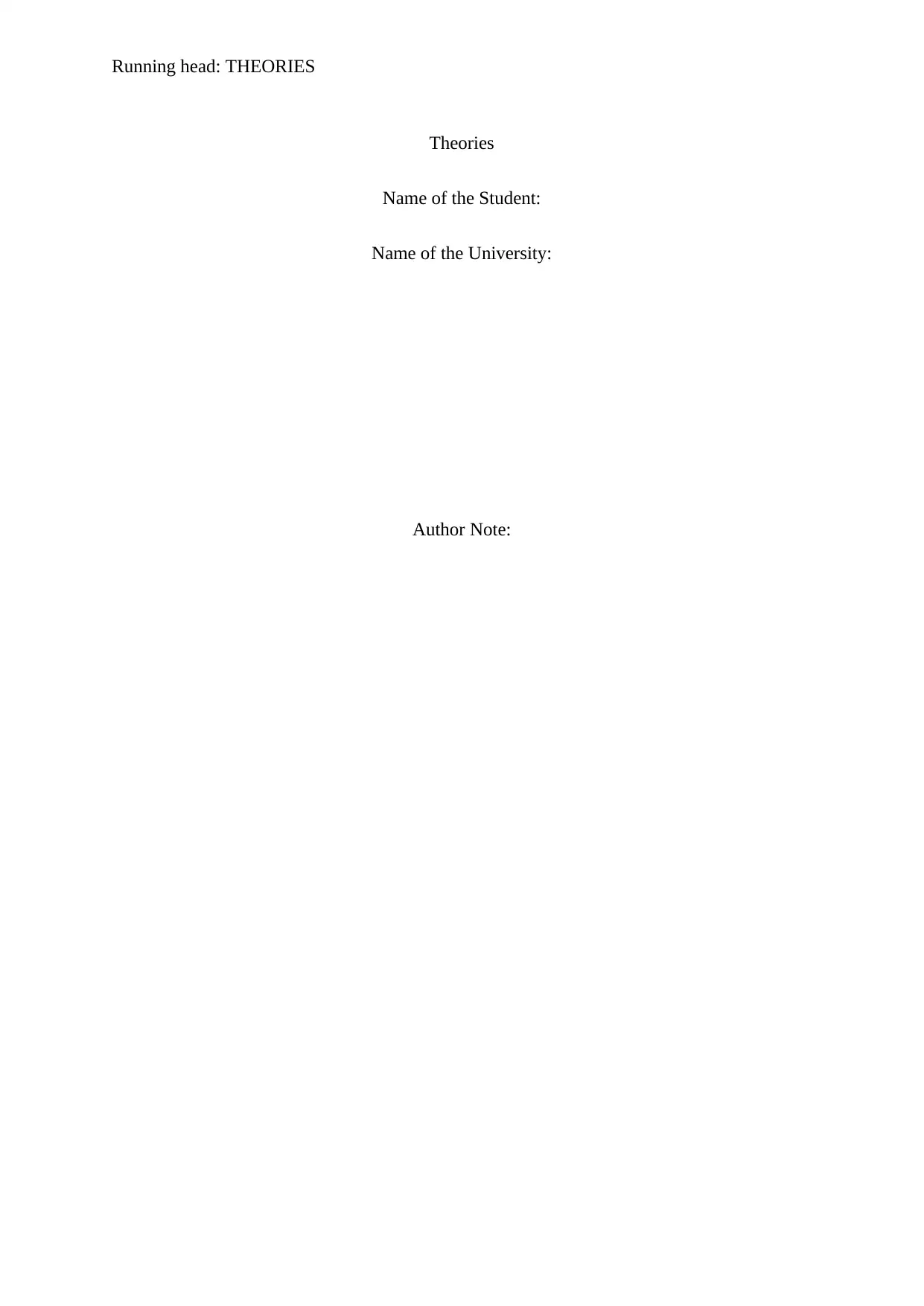
Running head: THEORIES
Theories
Name of the Student:
Name of the University:
Author Note:
Theories
Name of the Student:
Name of the University:
Author Note:
Paraphrase This Document
Need a fresh take? Get an instant paraphrase of this document with our AI Paraphraser
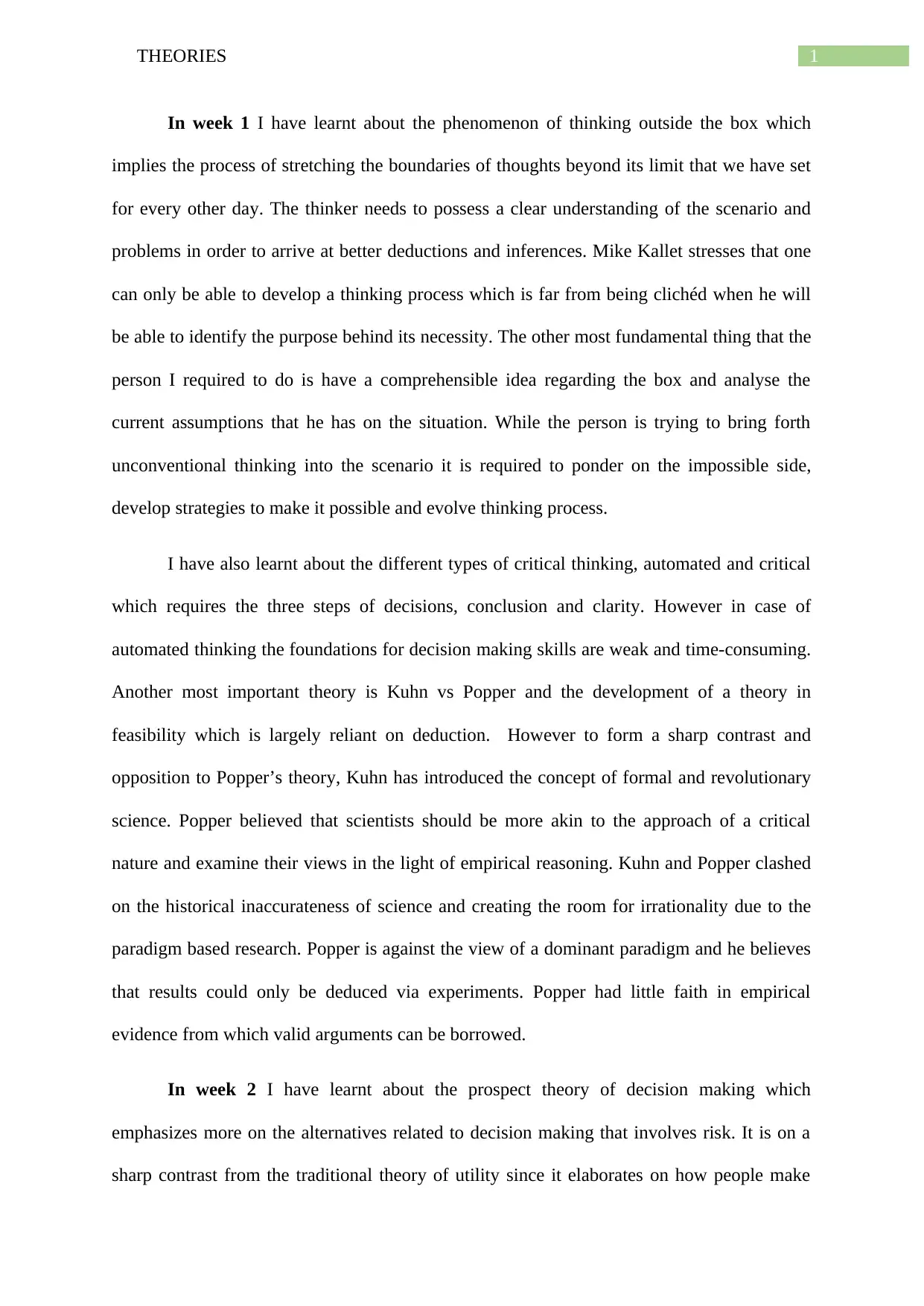
1THEORIES
In week 1 I have learnt about the phenomenon of thinking outside the box which
implies the process of stretching the boundaries of thoughts beyond its limit that we have set
for every other day. The thinker needs to possess a clear understanding of the scenario and
problems in order to arrive at better deductions and inferences. Mike Kallet stresses that one
can only be able to develop a thinking process which is far from being clichéd when he will
be able to identify the purpose behind its necessity. The other most fundamental thing that the
person I required to do is have a comprehensible idea regarding the box and analyse the
current assumptions that he has on the situation. While the person is trying to bring forth
unconventional thinking into the scenario it is required to ponder on the impossible side,
develop strategies to make it possible and evolve thinking process.
I have also learnt about the different types of critical thinking, automated and critical
which requires the three steps of decisions, conclusion and clarity. However in case of
automated thinking the foundations for decision making skills are weak and time-consuming.
Another most important theory is Kuhn vs Popper and the development of a theory in
feasibility which is largely reliant on deduction. However to form a sharp contrast and
opposition to Popper’s theory, Kuhn has introduced the concept of formal and revolutionary
science. Popper believed that scientists should be more akin to the approach of a critical
nature and examine their views in the light of empirical reasoning. Kuhn and Popper clashed
on the historical inaccurateness of science and creating the room for irrationality due to the
paradigm based research. Popper is against the view of a dominant paradigm and he believes
that results could only be deduced via experiments. Popper had little faith in empirical
evidence from which valid arguments can be borrowed.
In week 2 I have learnt about the prospect theory of decision making which
emphasizes more on the alternatives related to decision making that involves risk. It is on a
sharp contrast from the traditional theory of utility since it elaborates on how people make
In week 1 I have learnt about the phenomenon of thinking outside the box which
implies the process of stretching the boundaries of thoughts beyond its limit that we have set
for every other day. The thinker needs to possess a clear understanding of the scenario and
problems in order to arrive at better deductions and inferences. Mike Kallet stresses that one
can only be able to develop a thinking process which is far from being clichéd when he will
be able to identify the purpose behind its necessity. The other most fundamental thing that the
person I required to do is have a comprehensible idea regarding the box and analyse the
current assumptions that he has on the situation. While the person is trying to bring forth
unconventional thinking into the scenario it is required to ponder on the impossible side,
develop strategies to make it possible and evolve thinking process.
I have also learnt about the different types of critical thinking, automated and critical
which requires the three steps of decisions, conclusion and clarity. However in case of
automated thinking the foundations for decision making skills are weak and time-consuming.
Another most important theory is Kuhn vs Popper and the development of a theory in
feasibility which is largely reliant on deduction. However to form a sharp contrast and
opposition to Popper’s theory, Kuhn has introduced the concept of formal and revolutionary
science. Popper believed that scientists should be more akin to the approach of a critical
nature and examine their views in the light of empirical reasoning. Kuhn and Popper clashed
on the historical inaccurateness of science and creating the room for irrationality due to the
paradigm based research. Popper is against the view of a dominant paradigm and he believes
that results could only be deduced via experiments. Popper had little faith in empirical
evidence from which valid arguments can be borrowed.
In week 2 I have learnt about the prospect theory of decision making which
emphasizes more on the alternatives related to decision making that involves risk. It is on a
sharp contrast from the traditional theory of utility since it elaborates on how people make
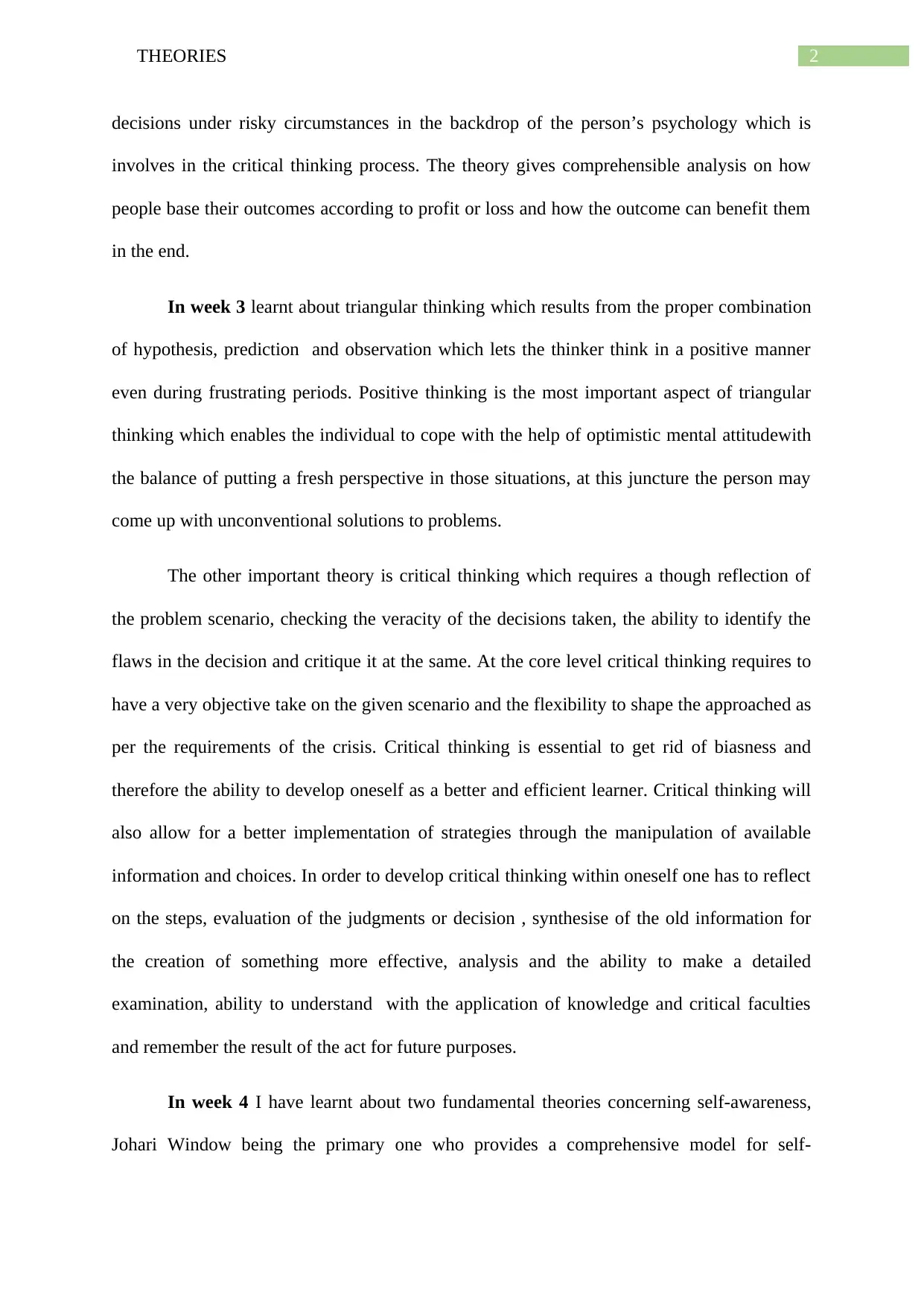
2THEORIES
decisions under risky circumstances in the backdrop of the person’s psychology which is
involves in the critical thinking process. The theory gives comprehensible analysis on how
people base their outcomes according to profit or loss and how the outcome can benefit them
in the end.
In week 3 learnt about triangular thinking which results from the proper combination
of hypothesis, prediction and observation which lets the thinker think in a positive manner
even during frustrating periods. Positive thinking is the most important aspect of triangular
thinking which enables the individual to cope with the help of optimistic mental attitudewith
the balance of putting a fresh perspective in those situations, at this juncture the person may
come up with unconventional solutions to problems.
The other important theory is critical thinking which requires a though reflection of
the problem scenario, checking the veracity of the decisions taken, the ability to identify the
flaws in the decision and critique it at the same. At the core level critical thinking requires to
have a very objective take on the given scenario and the flexibility to shape the approached as
per the requirements of the crisis. Critical thinking is essential to get rid of biasness and
therefore the ability to develop oneself as a better and efficient learner. Critical thinking will
also allow for a better implementation of strategies through the manipulation of available
information and choices. In order to develop critical thinking within oneself one has to reflect
on the steps, evaluation of the judgments or decision , synthesise of the old information for
the creation of something more effective, analysis and the ability to make a detailed
examination, ability to understand with the application of knowledge and critical faculties
and remember the result of the act for future purposes.
In week 4 I have learnt about two fundamental theories concerning self-awareness,
Johari Window being the primary one who provides a comprehensive model for self-
decisions under risky circumstances in the backdrop of the person’s psychology which is
involves in the critical thinking process. The theory gives comprehensible analysis on how
people base their outcomes according to profit or loss and how the outcome can benefit them
in the end.
In week 3 learnt about triangular thinking which results from the proper combination
of hypothesis, prediction and observation which lets the thinker think in a positive manner
even during frustrating periods. Positive thinking is the most important aspect of triangular
thinking which enables the individual to cope with the help of optimistic mental attitudewith
the balance of putting a fresh perspective in those situations, at this juncture the person may
come up with unconventional solutions to problems.
The other important theory is critical thinking which requires a though reflection of
the problem scenario, checking the veracity of the decisions taken, the ability to identify the
flaws in the decision and critique it at the same. At the core level critical thinking requires to
have a very objective take on the given scenario and the flexibility to shape the approached as
per the requirements of the crisis. Critical thinking is essential to get rid of biasness and
therefore the ability to develop oneself as a better and efficient learner. Critical thinking will
also allow for a better implementation of strategies through the manipulation of available
information and choices. In order to develop critical thinking within oneself one has to reflect
on the steps, evaluation of the judgments or decision , synthesise of the old information for
the creation of something more effective, analysis and the ability to make a detailed
examination, ability to understand with the application of knowledge and critical faculties
and remember the result of the act for future purposes.
In week 4 I have learnt about two fundamental theories concerning self-awareness,
Johari Window being the primary one who provides a comprehensive model for self-
⊘ This is a preview!⊘
Do you want full access?
Subscribe today to unlock all pages.

Trusted by 1+ million students worldwide
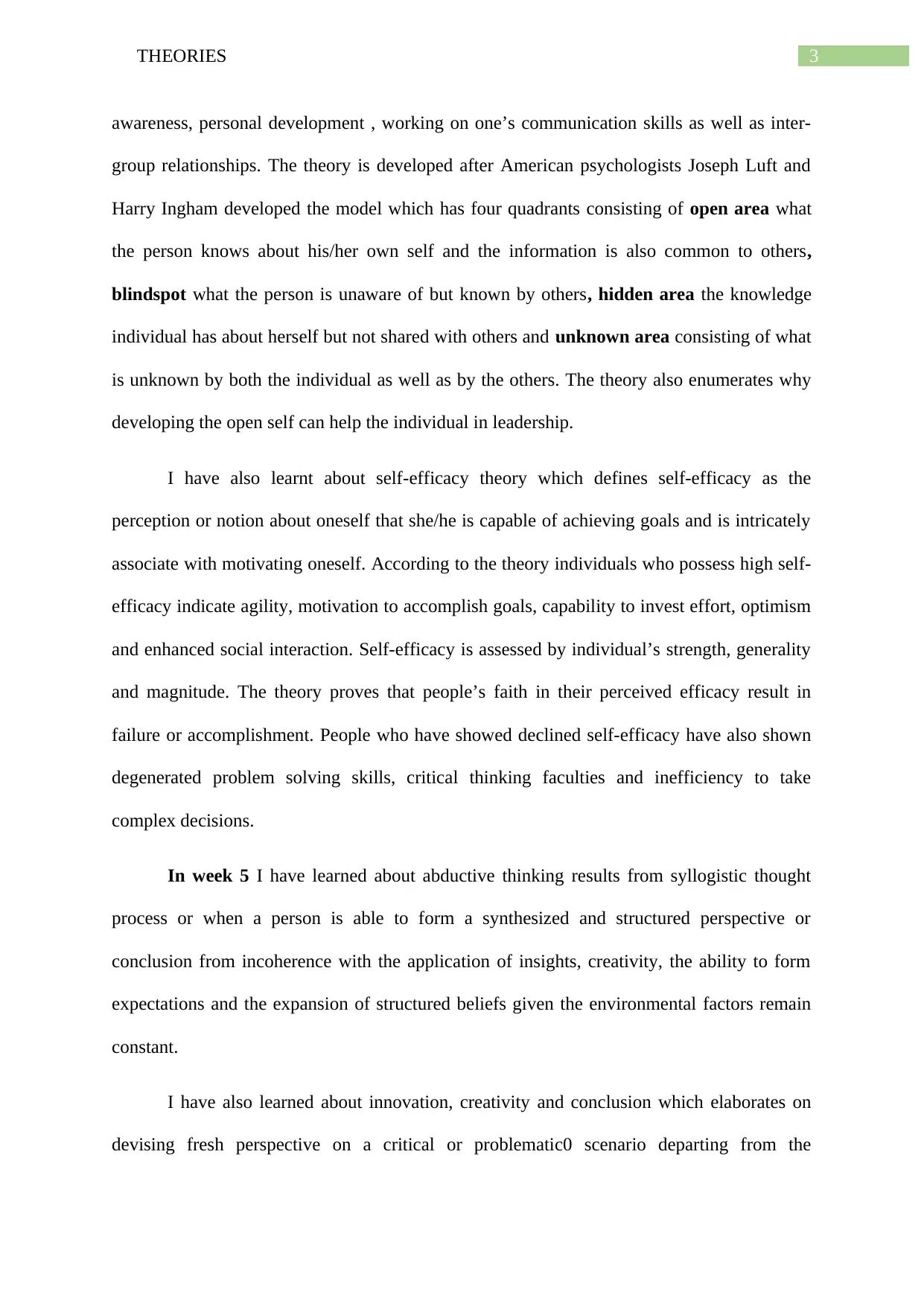
3THEORIES
awareness, personal development , working on one’s communication skills as well as inter-
group relationships. The theory is developed after American psychologists Joseph Luft and
Harry Ingham developed the model which has four quadrants consisting of open area what
the person knows about his/her own self and the information is also common to others,
blindspot what the person is unaware of but known by others, hidden area the knowledge
individual has about herself but not shared with others and unknown area consisting of what
is unknown by both the individual as well as by the others. The theory also enumerates why
developing the open self can help the individual in leadership.
I have also learnt about self-efficacy theory which defines self-efficacy as the
perception or notion about oneself that she/he is capable of achieving goals and is intricately
associate with motivating oneself. According to the theory individuals who possess high self-
efficacy indicate agility, motivation to accomplish goals, capability to invest effort, optimism
and enhanced social interaction. Self-efficacy is assessed by individual’s strength, generality
and magnitude. The theory proves that people’s faith in their perceived efficacy result in
failure or accomplishment. People who have showed declined self-efficacy have also shown
degenerated problem solving skills, critical thinking faculties and inefficiency to take
complex decisions.
In week 5 I have learned about abductive thinking results from syllogistic thought
process or when a person is able to form a synthesized and structured perspective or
conclusion from incoherence with the application of insights, creativity, the ability to form
expectations and the expansion of structured beliefs given the environmental factors remain
constant.
I have also learned about innovation, creativity and conclusion which elaborates on
devising fresh perspective on a critical or problematic0 scenario departing from the
awareness, personal development , working on one’s communication skills as well as inter-
group relationships. The theory is developed after American psychologists Joseph Luft and
Harry Ingham developed the model which has four quadrants consisting of open area what
the person knows about his/her own self and the information is also common to others,
blindspot what the person is unaware of but known by others, hidden area the knowledge
individual has about herself but not shared with others and unknown area consisting of what
is unknown by both the individual as well as by the others. The theory also enumerates why
developing the open self can help the individual in leadership.
I have also learnt about self-efficacy theory which defines self-efficacy as the
perception or notion about oneself that she/he is capable of achieving goals and is intricately
associate with motivating oneself. According to the theory individuals who possess high self-
efficacy indicate agility, motivation to accomplish goals, capability to invest effort, optimism
and enhanced social interaction. Self-efficacy is assessed by individual’s strength, generality
and magnitude. The theory proves that people’s faith in their perceived efficacy result in
failure or accomplishment. People who have showed declined self-efficacy have also shown
degenerated problem solving skills, critical thinking faculties and inefficiency to take
complex decisions.
In week 5 I have learned about abductive thinking results from syllogistic thought
process or when a person is able to form a synthesized and structured perspective or
conclusion from incoherence with the application of insights, creativity, the ability to form
expectations and the expansion of structured beliefs given the environmental factors remain
constant.
I have also learned about innovation, creativity and conclusion which elaborates on
devising fresh perspective on a critical or problematic0 scenario departing from the
Paraphrase This Document
Need a fresh take? Get an instant paraphrase of this document with our AI Paraphraser
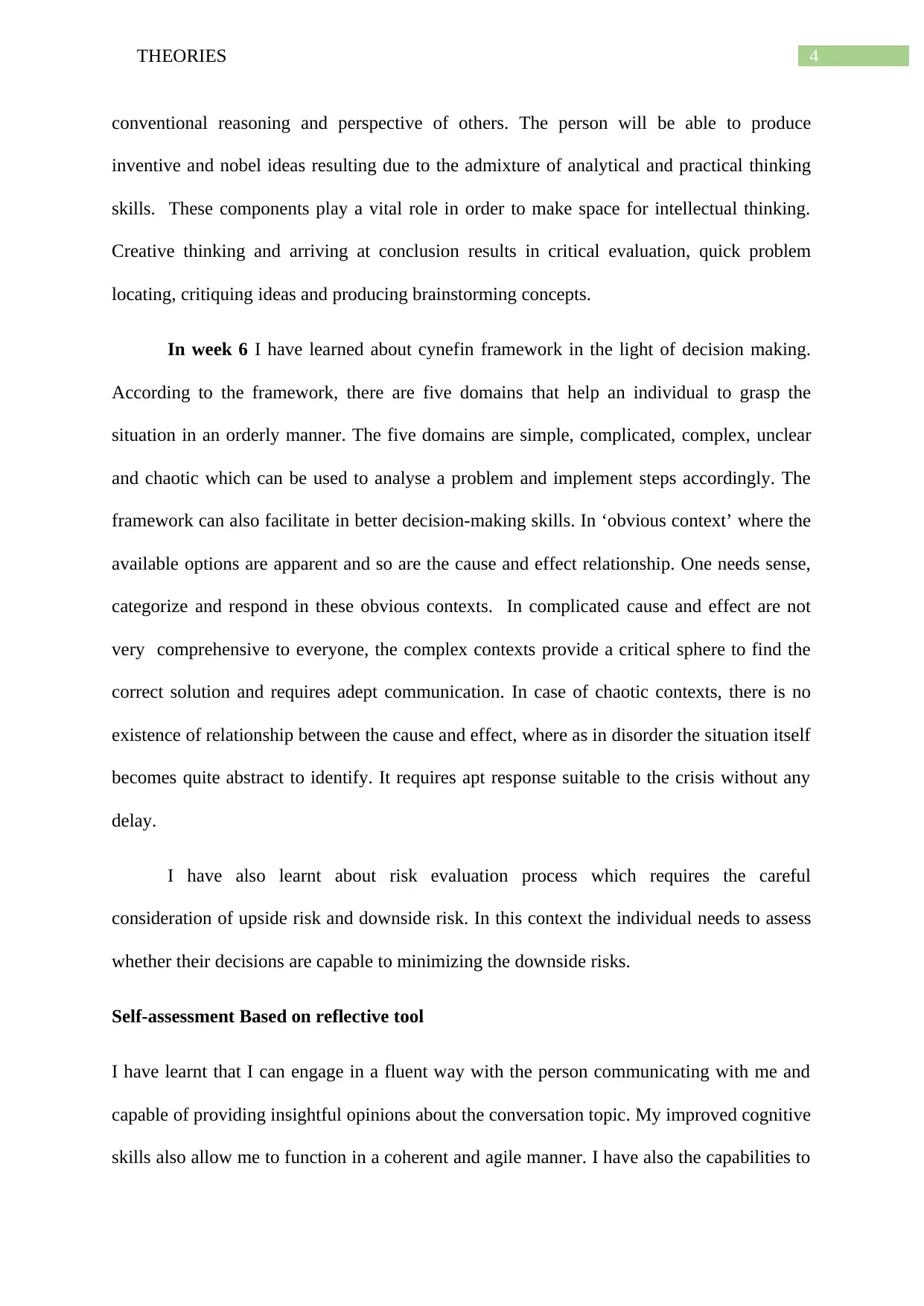
4THEORIES
conventional reasoning and perspective of others. The person will be able to produce
inventive and nobel ideas resulting due to the admixture of analytical and practical thinking
skills. These components play a vital role in order to make space for intellectual thinking.
Creative thinking and arriving at conclusion results in critical evaluation, quick problem
locating, critiquing ideas and producing brainstorming concepts.
In week 6 I have learned about cynefin framework in the light of decision making.
According to the framework, there are five domains that help an individual to grasp the
situation in an orderly manner. The five domains are simple, complicated, complex, unclear
and chaotic which can be used to analyse a problem and implement steps accordingly. The
framework can also facilitate in better decision-making skills. In ‘obvious context’ where the
available options are apparent and so are the cause and effect relationship. One needs sense,
categorize and respond in these obvious contexts. In complicated cause and effect are not
very comprehensive to everyone, the complex contexts provide a critical sphere to find the
correct solution and requires adept communication. In case of chaotic contexts, there is no
existence of relationship between the cause and effect, where as in disorder the situation itself
becomes quite abstract to identify. It requires apt response suitable to the crisis without any
delay.
I have also learnt about risk evaluation process which requires the careful
consideration of upside risk and downside risk. In this context the individual needs to assess
whether their decisions are capable to minimizing the downside risks.
Self-assessment Based on reflective tool
I have learnt that I can engage in a fluent way with the person communicating with me and
capable of providing insightful opinions about the conversation topic. My improved cognitive
skills also allow me to function in a coherent and agile manner. I have also the capabilities to
conventional reasoning and perspective of others. The person will be able to produce
inventive and nobel ideas resulting due to the admixture of analytical and practical thinking
skills. These components play a vital role in order to make space for intellectual thinking.
Creative thinking and arriving at conclusion results in critical evaluation, quick problem
locating, critiquing ideas and producing brainstorming concepts.
In week 6 I have learned about cynefin framework in the light of decision making.
According to the framework, there are five domains that help an individual to grasp the
situation in an orderly manner. The five domains are simple, complicated, complex, unclear
and chaotic which can be used to analyse a problem and implement steps accordingly. The
framework can also facilitate in better decision-making skills. In ‘obvious context’ where the
available options are apparent and so are the cause and effect relationship. One needs sense,
categorize and respond in these obvious contexts. In complicated cause and effect are not
very comprehensive to everyone, the complex contexts provide a critical sphere to find the
correct solution and requires adept communication. In case of chaotic contexts, there is no
existence of relationship between the cause and effect, where as in disorder the situation itself
becomes quite abstract to identify. It requires apt response suitable to the crisis without any
delay.
I have also learnt about risk evaluation process which requires the careful
consideration of upside risk and downside risk. In this context the individual needs to assess
whether their decisions are capable to minimizing the downside risks.
Self-assessment Based on reflective tool
I have learnt that I can engage in a fluent way with the person communicating with me and
capable of providing insightful opinions about the conversation topic. My improved cognitive
skills also allow me to function in a coherent and agile manner. I have also the capabilities to
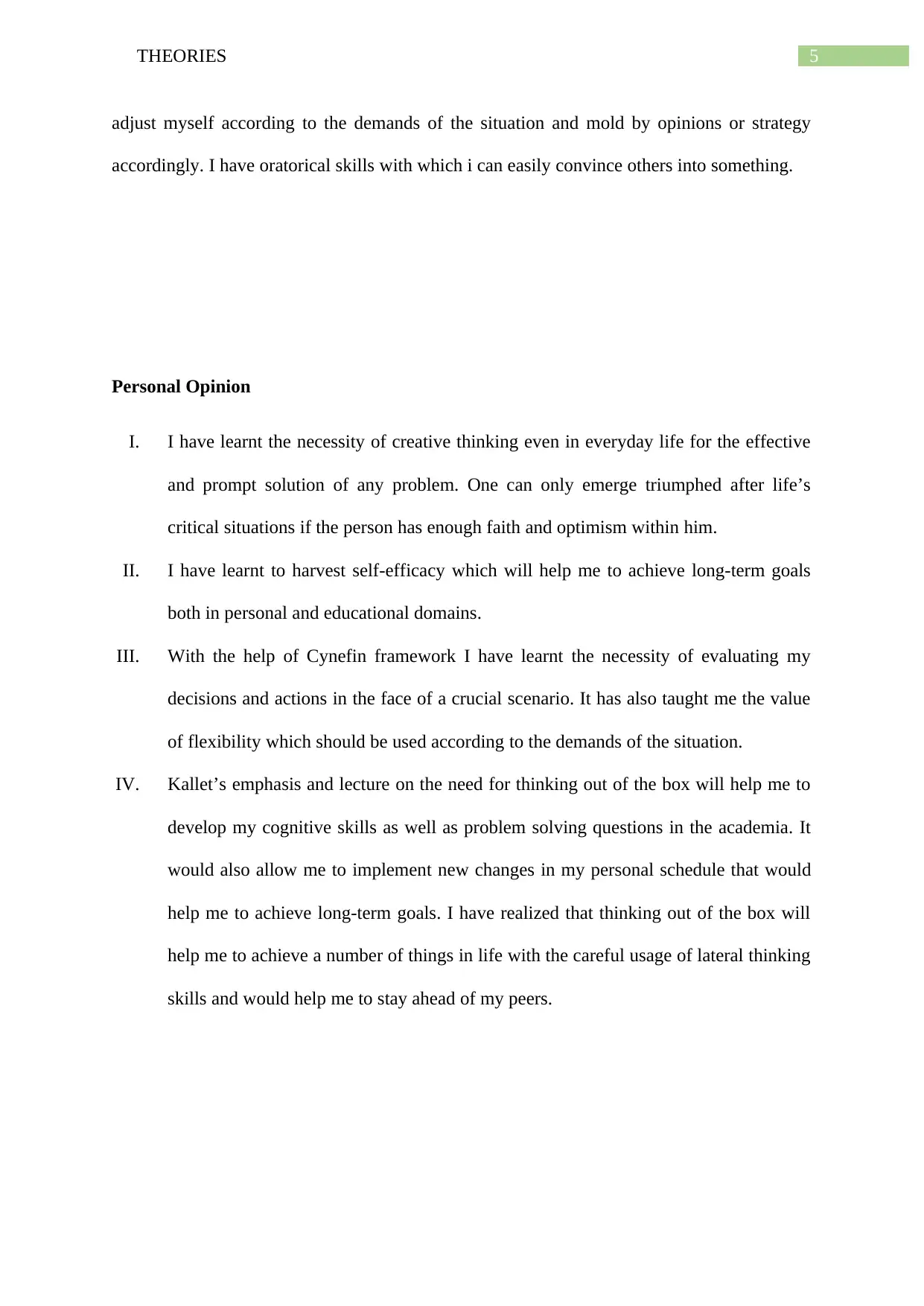
5THEORIES
adjust myself according to the demands of the situation and mold by opinions or strategy
accordingly. I have oratorical skills with which i can easily convince others into something.
Personal Opinion
I. I have learnt the necessity of creative thinking even in everyday life for the effective
and prompt solution of any problem. One can only emerge triumphed after life’s
critical situations if the person has enough faith and optimism within him.
II. I have learnt to harvest self-efficacy which will help me to achieve long-term goals
both in personal and educational domains.
III. With the help of Cynefin framework I have learnt the necessity of evaluating my
decisions and actions in the face of a crucial scenario. It has also taught me the value
of flexibility which should be used according to the demands of the situation.
IV. Kallet’s emphasis and lecture on the need for thinking out of the box will help me to
develop my cognitive skills as well as problem solving questions in the academia. It
would also allow me to implement new changes in my personal schedule that would
help me to achieve long-term goals. I have realized that thinking out of the box will
help me to achieve a number of things in life with the careful usage of lateral thinking
skills and would help me to stay ahead of my peers.
adjust myself according to the demands of the situation and mold by opinions or strategy
accordingly. I have oratorical skills with which i can easily convince others into something.
Personal Opinion
I. I have learnt the necessity of creative thinking even in everyday life for the effective
and prompt solution of any problem. One can only emerge triumphed after life’s
critical situations if the person has enough faith and optimism within him.
II. I have learnt to harvest self-efficacy which will help me to achieve long-term goals
both in personal and educational domains.
III. With the help of Cynefin framework I have learnt the necessity of evaluating my
decisions and actions in the face of a crucial scenario. It has also taught me the value
of flexibility which should be used according to the demands of the situation.
IV. Kallet’s emphasis and lecture on the need for thinking out of the box will help me to
develop my cognitive skills as well as problem solving questions in the academia. It
would also allow me to implement new changes in my personal schedule that would
help me to achieve long-term goals. I have realized that thinking out of the box will
help me to achieve a number of things in life with the careful usage of lateral thinking
skills and would help me to stay ahead of my peers.
⊘ This is a preview!⊘
Do you want full access?
Subscribe today to unlock all pages.

Trusted by 1+ million students worldwide
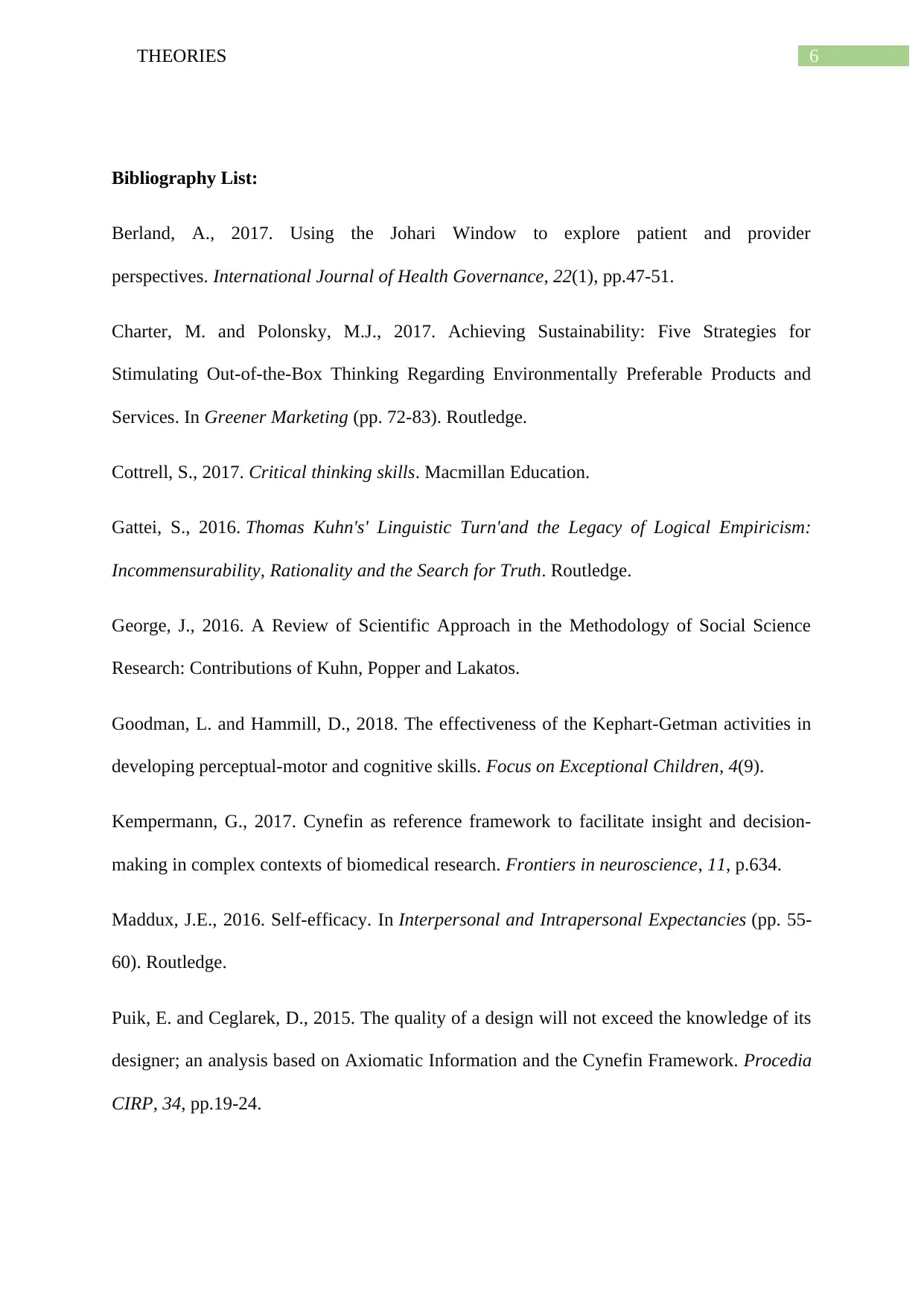
6THEORIES
Bibliography List:
Berland, A., 2017. Using the Johari Window to explore patient and provider
perspectives. International Journal of Health Governance, 22(1), pp.47-51.
Charter, M. and Polonsky, M.J., 2017. Achieving Sustainability: Five Strategies for
Stimulating Out-of-the-Box Thinking Regarding Environmentally Preferable Products and
Services. In Greener Marketing (pp. 72-83). Routledge.
Cottrell, S., 2017. Critical thinking skills. Macmillan Education.
Gattei, S., 2016. Thomas Kuhn's' Linguistic Turn'and the Legacy of Logical Empiricism:
Incommensurability, Rationality and the Search for Truth. Routledge.
George, J., 2016. A Review of Scientific Approach in the Methodology of Social Science
Research: Contributions of Kuhn, Popper and Lakatos.
Goodman, L. and Hammill, D., 2018. The effectiveness of the Kephart-Getman activities in
developing perceptual-motor and cognitive skills. Focus on Exceptional Children, 4(9).
Kempermann, G., 2017. Cynefin as reference framework to facilitate insight and decision-
making in complex contexts of biomedical research. Frontiers in neuroscience, 11, p.634.
Maddux, J.E., 2016. Self-efficacy. In Interpersonal and Intrapersonal Expectancies (pp. 55-
60). Routledge.
Puik, E. and Ceglarek, D., 2015. The quality of a design will not exceed the knowledge of its
designer; an analysis based on Axiomatic Information and the Cynefin Framework. Procedia
CIRP, 34, pp.19-24.
Bibliography List:
Berland, A., 2017. Using the Johari Window to explore patient and provider
perspectives. International Journal of Health Governance, 22(1), pp.47-51.
Charter, M. and Polonsky, M.J., 2017. Achieving Sustainability: Five Strategies for
Stimulating Out-of-the-Box Thinking Regarding Environmentally Preferable Products and
Services. In Greener Marketing (pp. 72-83). Routledge.
Cottrell, S., 2017. Critical thinking skills. Macmillan Education.
Gattei, S., 2016. Thomas Kuhn's' Linguistic Turn'and the Legacy of Logical Empiricism:
Incommensurability, Rationality and the Search for Truth. Routledge.
George, J., 2016. A Review of Scientific Approach in the Methodology of Social Science
Research: Contributions of Kuhn, Popper and Lakatos.
Goodman, L. and Hammill, D., 2018. The effectiveness of the Kephart-Getman activities in
developing perceptual-motor and cognitive skills. Focus on Exceptional Children, 4(9).
Kempermann, G., 2017. Cynefin as reference framework to facilitate insight and decision-
making in complex contexts of biomedical research. Frontiers in neuroscience, 11, p.634.
Maddux, J.E., 2016. Self-efficacy. In Interpersonal and Intrapersonal Expectancies (pp. 55-
60). Routledge.
Puik, E. and Ceglarek, D., 2015. The quality of a design will not exceed the knowledge of its
designer; an analysis based on Axiomatic Information and the Cynefin Framework. Procedia
CIRP, 34, pp.19-24.
Paraphrase This Document
Need a fresh take? Get an instant paraphrase of this document with our AI Paraphraser
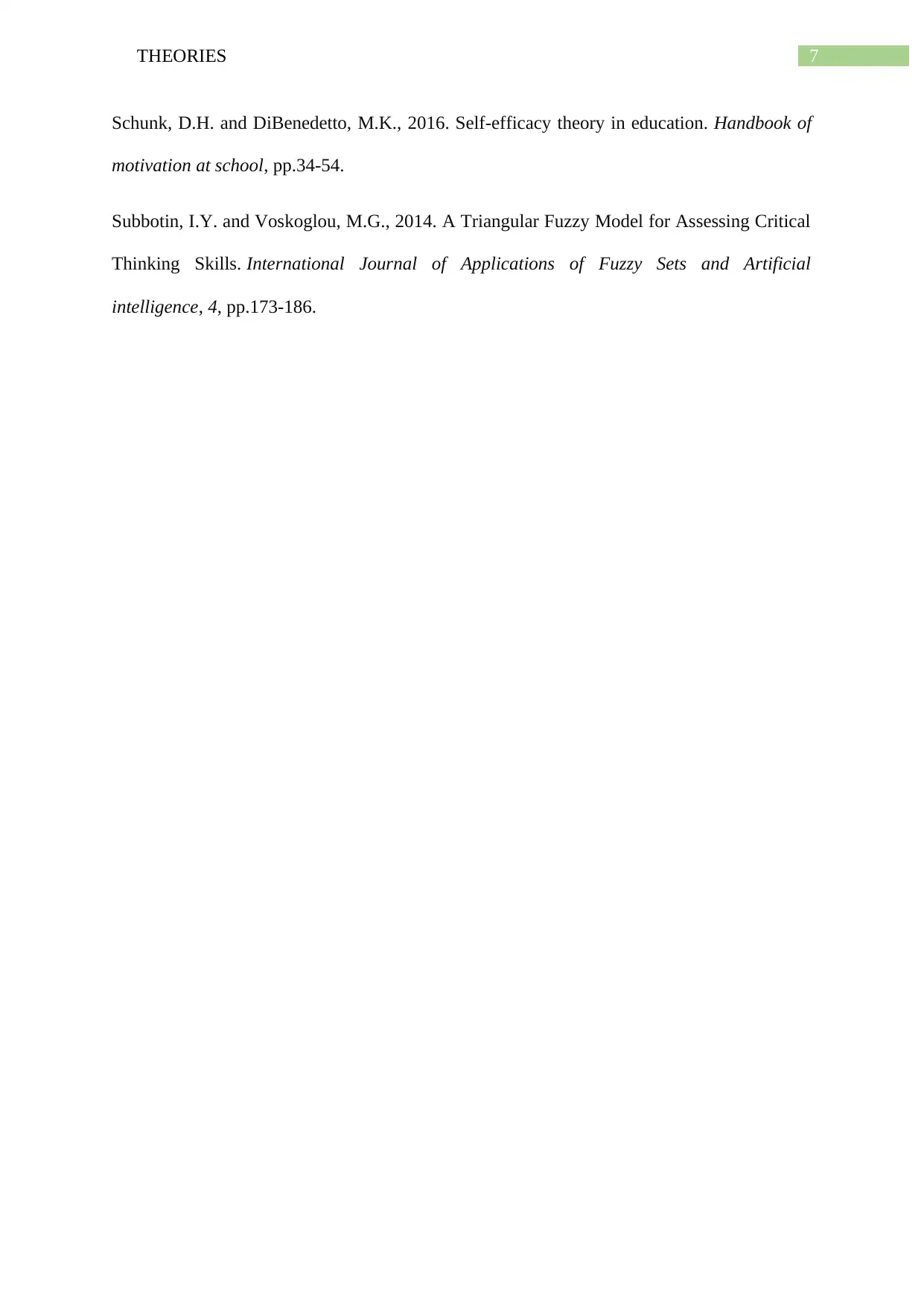
7THEORIES
Schunk, D.H. and DiBenedetto, M.K., 2016. Self-efficacy theory in education. Handbook of
motivation at school, pp.34-54.
Subbotin, I.Y. and Voskoglou, M.G., 2014. A Triangular Fuzzy Model for Assessing Critical
Thinking Skills. International Journal of Applications of Fuzzy Sets and Artificial
intelligence, 4, pp.173-186.
Schunk, D.H. and DiBenedetto, M.K., 2016. Self-efficacy theory in education. Handbook of
motivation at school, pp.34-54.
Subbotin, I.Y. and Voskoglou, M.G., 2014. A Triangular Fuzzy Model for Assessing Critical
Thinking Skills. International Journal of Applications of Fuzzy Sets and Artificial
intelligence, 4, pp.173-186.
1 out of 8
Your All-in-One AI-Powered Toolkit for Academic Success.
+13062052269
info@desklib.com
Available 24*7 on WhatsApp / Email
![[object Object]](/_next/static/media/star-bottom.7253800d.svg)
Unlock your academic potential
Copyright © 2020–2025 A2Z Services. All Rights Reserved. Developed and managed by ZUCOL.
